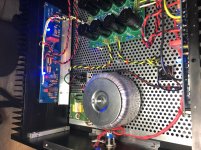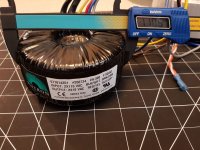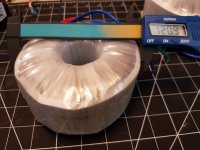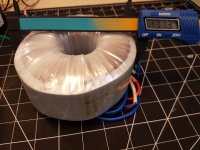So what you are saying is. My transformer is a bit on the smal side maybee.
But i dont think i have room for two of them.
Yes, your transformer definitely is on the small side. The evidence is the size of the secondary wires and the excessive heat. I think with some clever rearranging of components, you could make room for two of them.
Try ZM solution first with two toroids. Later you kan build full dual mono PSU that is definetly the best 🙂
Just for clarification, I believe 6L6 was saying to parallel the 2 windings on a given transformer and use that transformer for one side of the supply either positive or negative. This should not cause any issues at all. I would not parallel 2 windings from different transformers as that would likely cause some problems. Given that the Aleph J has a limited current output I would think going full dual mono supplies would have minimal benefit compared to an amp with a wider current output range such as F5.
I was just inside my Aleph J yesterday to check it before putting it back into service. I am using 20v 400va transformer - with a clc supply. I measured +-23.7 volts and ac rippple of only 2 or 3 mv. This amp is dead quiet even on high efficiency speakers.
I was running an ACA into a pair of mid sized bookshelf speakers and when I switched to the J it was much more refined, dynamic and musical, which surprised me given that the ACA sounded pretty good. Aleph J is a very good amplifier for speakers that can live with it’s power rating and its output impedance.
I was just inside my Aleph J yesterday to check it before putting it back into service. I am using 20v 400va transformer - with a clc supply. I measured +-23.7 volts and ac rippple of only 2 or 3 mv. This amp is dead quiet even on high efficiency speakers.
I was running an ACA into a pair of mid sized bookshelf speakers and when I switched to the J it was much more refined, dynamic and musical, which surprised me given that the ACA sounded pretty good. Aleph J is a very good amplifier for speakers that can live with it’s power rating and its output impedance.
I did paralleling of windings of (one) xformer in the past , but only when I was certain ( after visual inspection) that two windings are bifillary wound
in all other cases , I did paralleling after bridges
same case here - either full dual mono , or connecting both xformes to one cap bank , after bridges ..... obviously - each xformer having own bridge(s)
in all other cases , I did paralleling after bridges
same case here - either full dual mono , or connecting both xformes to one cap bank , after bridges ..... obviously - each xformer having own bridge(s)
I did paralleling of windings of (one) xformer in the past , but only when I was certain ( after visual inspection) that two windings are bifillary wound
in all other cases , I did paralleling after bridges
same case here - either full dual mono , or connecting both xformes to one cap bank , after bridges ..... obviously - each xformer having own bridge(s)
I have done it a few times and never had any difficulty. What I do is to parallel the windings and monitor the line current to see if it goes up after paralleling. Many transformers have primaries that are designed for parallel or series use to accommodate 120/240 volt use. This may not be as common outside North America where we have 120v as standard resisdential voltage. I think it is always better to have the exact specified transformer for the job but as DIY builders we often have to improvise to get the job done.
agree about primary - paralleling is completelly normal , when needed
though , at least in my neck of wood , secondaries are trickier (logically)
I have no worries only with bifillars ....
though , at least in my neck of wood , secondaries are trickier (logically)
I have no worries only with bifillars ....
Just for clarification, I believe 6L6 was saying to parallel the 2 windings on a given transformer and use that transformer for one side of the supply either positive or negative. This should not cause any issues at all. I would not parallel 2 windings from different transformers as that would likely cause some problems. Given that the Aleph J has a limited current output I would think going full dual mono supplies would have minimal benefit compared to an amp with a wider current output range such as F5.
I was just inside my Aleph J yesterday to check it before putting it back into service. I am using 20v 400va transformer - with a clc supply. I measured +-23.7 volts and ac rippple of only 2 or 3 mv. This amp is dead quiet even on high efficiency speakers.
I was running an ACA into a pair of mid sized bookshelf speakers and when I switched to the J it was much more refined, dynamic and musical, which surprised me given that the ACA sounded pretty good. Aleph J is a very good amplifier for speakers that can live with it’s power rating and its output impedance.
I looked at mine last night as well and have similar findings as you. CLC supply, 300va - 20v secondaries and left at idle for an hour with lid on and I got readings of 42 degree Celsius on transformer. That's with a bias of 420 and 55 degree Celsius on the sinks in a 4U chassis
CLC supply is the bomb for getting rid of supply ripple. Mine is somewhat unconventional using fan cooling in a home built chassis. I am running around .45v on the source resistors.
Anyway, here’s a link to the amp build if anyone is interested.
Another Aleph J, fan cooled, LC filtered supply
Anyway, here’s a link to the amp build if anyone is interested.
Another Aleph J, fan cooled, LC filtered supply
Thanks for the help guys. I have to look deep in my wallet and see if i can buy another transformer then 🙂 And i will certanly return to get some help on how to do it.
Maybe... if lowering Iq to about 1.3A will help? Same as F5? Output power will go down a bit, distortion increase don't know how much..? 🙂
@nikko03 I can't tell how big your transformer is but if it's truly 300VA it should be enough.
For comparison, here are 300VA potted Plitron, shielded Antek 3218, shielded Antek 4218 (300va and 400va).
Caliper reading in mm, but board underneath squares should be 1 inch
For comparison, here are 300VA potted Plitron, shielded Antek 3218, shielded Antek 4218 (300va and 400va).
Caliper reading in mm, but board underneath squares should be 1 inch
Attachments
@nikko03 I can't tell how big your transformer is but if it's truly 300VA it should be enough.
For comparison, here are 300VA potted Plitron, shielded Antek 3218, shielded Antek 4218 (300va and 400va).
Caliper reading in mm, but board underneath squares should be 1 inch
I measured my transformer yesterday. And it it 110mm rougly the same size as the one on the first picture.
Maybe... if lowering Iq to about 1.3A will help? Same as F5? Output power will go down a bit, distortion increase don't know how much..? 🙂
'I will try this. then maybe my amp lives longer 🙂
Hi i think i found the problem with overheating.
Drilled more holes in bottom near transformer and rectifier bridges.
Now i am down to 55c near the bottom of transformer. 50c on top.
I quess this is ok 🙂
Drilled more holes in bottom near transformer and rectifier bridges.
Now i am down to 55c near the bottom of transformer. 50c on top.
I quess this is ok 🙂
finally ....... it was air constipation ......
and silly we .......... we didn't asked what is temperature of other parts inside
and silly we .......... we didn't asked what is temperature of other parts inside

Amazing what a little convection cooling will do! Now you can enjoy the sound of your new amp without worry.
- Home
- Amplifiers
- Pass Labs
- Aleph J illustrated build guide



